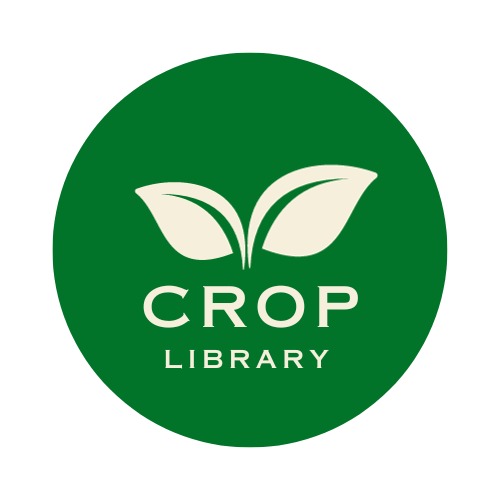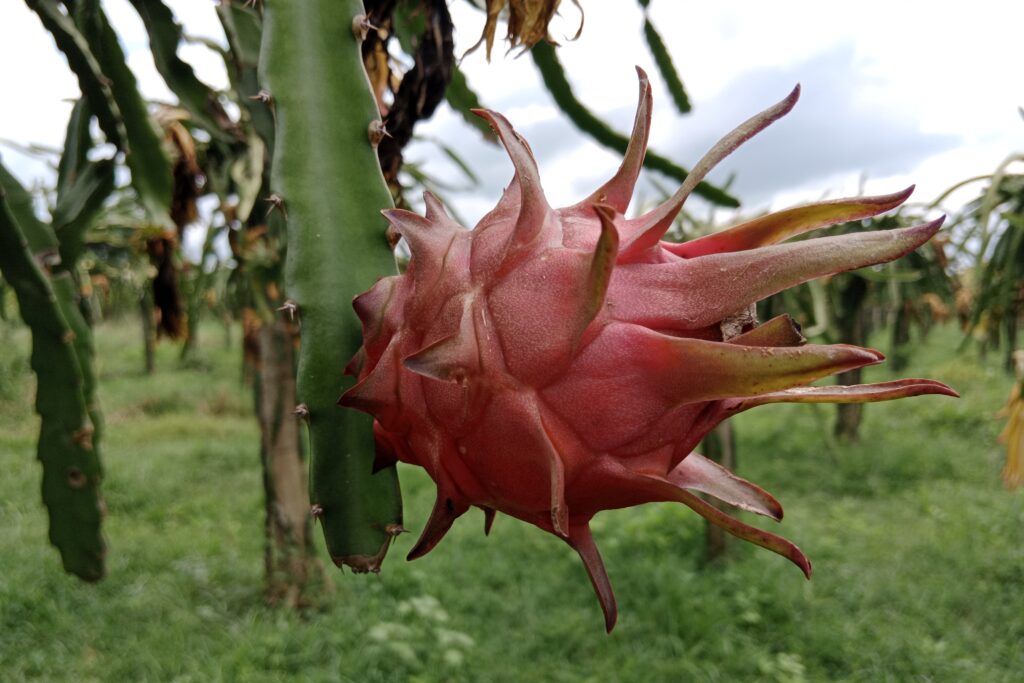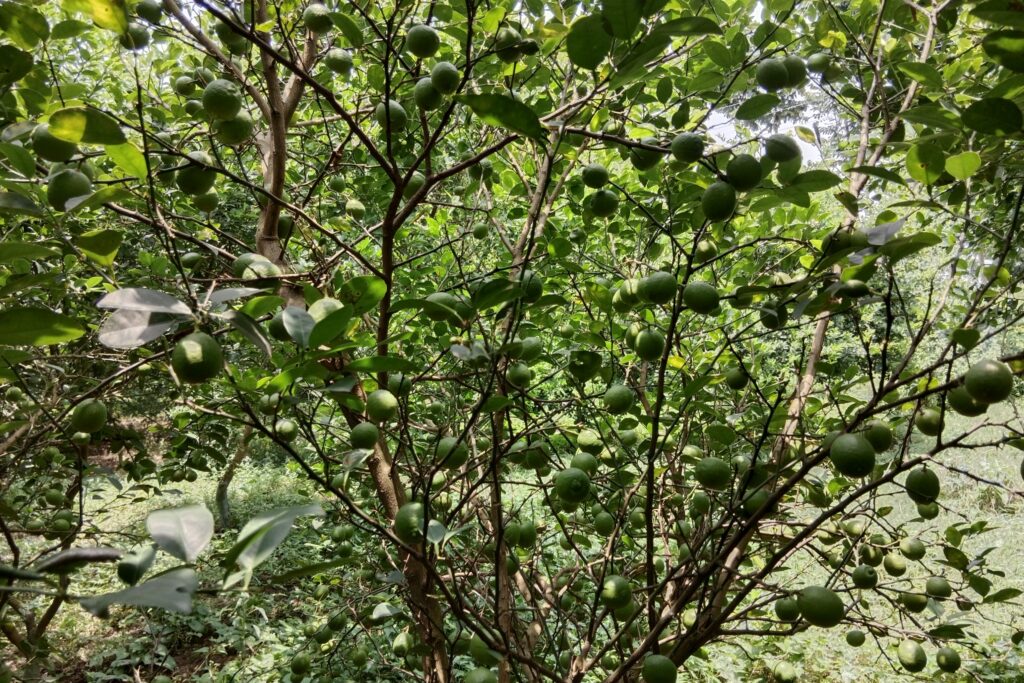Chayote Farming
Chayote, also known as vegetable pear, mirliton, choko, or christophene, is a perennial vine belonging to the Cucurbitaceae (gourd) family. It is primarily cultivated for its pear-shaped, wrinkled or smooth fruit, but its tuberous roots, tender shoots, and leaves are also edible. It is a highly productive and relatively low-maintenance crop once established.
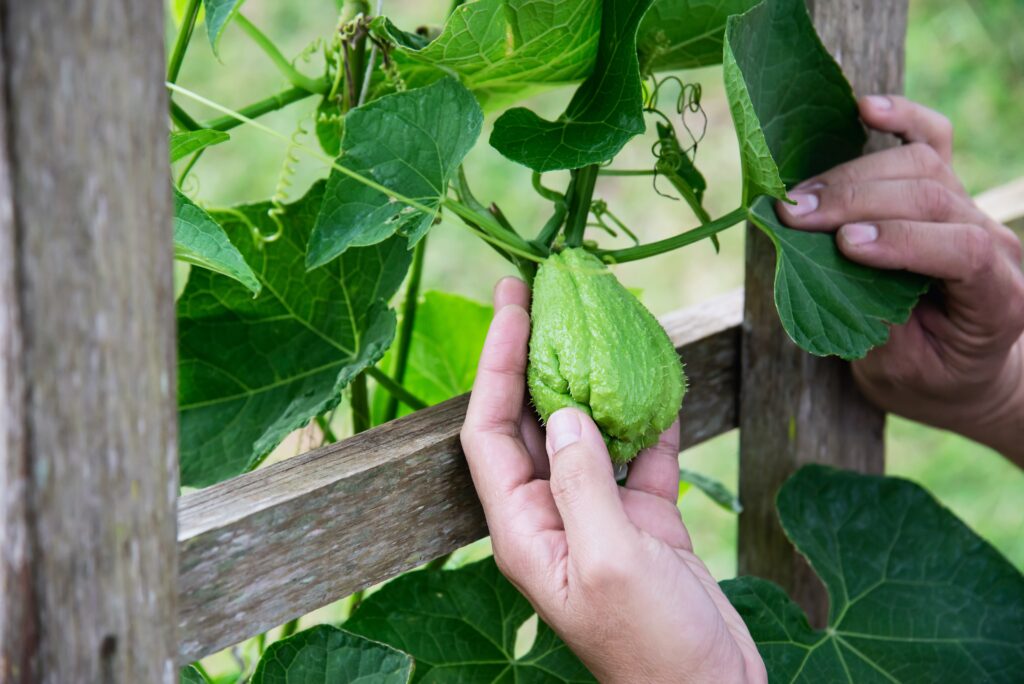
For agricultural entrepreneurs seeking a high-return venture, chayote farming profit per acre presents an exceptionally compelling opportunity. This perennial crop demonstrates robust and rapid financial performance, achieving a significant first-year net profit of approximately NPR 107,000 and reaching the break-even point within the same initial season.
The investment yield peaks spectacularly in the second year, where optimized productivity can generate profits soaring to NPR 180,000 per acre. Subsequently, the venture offers remarkable stability, with annual profits consistently settling around NPR 120,000 from the third year onward.
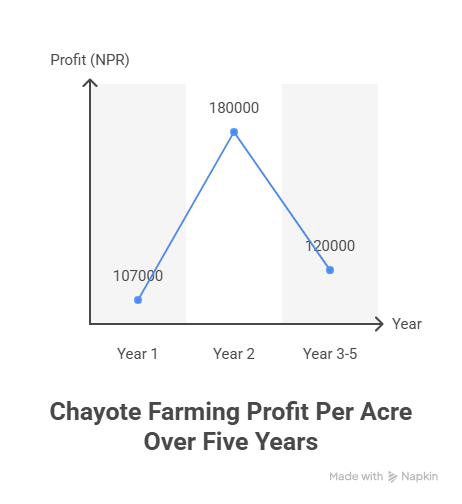
Cumulatively, this translates to an impressive profit margin of approximately 75% over a standard five-year cycle, solidifying chayote cultivation’s status as a highly lucrative and sustainable horticultural investment.
Land Preparation
For chayote cultivation, land preparation aims to create a loose, well-drained, and weed-free seedbed that supports healthy root development. The process begins with deep plowing to a depth of 30–40 cm to break hardpans and improve soil aeration, followed by 2–3 rounds of harrowing to break down soil clods and level the field for uniform water distribution and to prevent waterlogging.
During the final harrowing, 15–20 tonnes per acre of well-decomposed farmyard manure (FYM) or compost should be incorporated to enrich the soil with organic matter. Finally, the field is marked according to the recommended spacing in preparation for pit digging.
Soil Type
The ideal growing conditions for chayote are deep, well-drained sandy loam to loamy soils that are rich in organic matter and have a pH between 5.5 and 7.0, which is slightly acidic to neutral. Although the soil should be able to hold water well enough to promote healthy growth, too much moisture retention, as in thick clay soils, can cause root rot and impede plant growth, therefore adequate drainage is crucial.
Climatic Requirements
Warm-season crops like chayote thrive in cool, temperate regions, especially in tropical and subtropical highlands. While temperatures exceeding 32°C (90°F) can decrease pollination and fruit set, it grows best around 13°C to 21°C (55°F to 70°F), tolerating minor frosts but withering under heavy frosts.
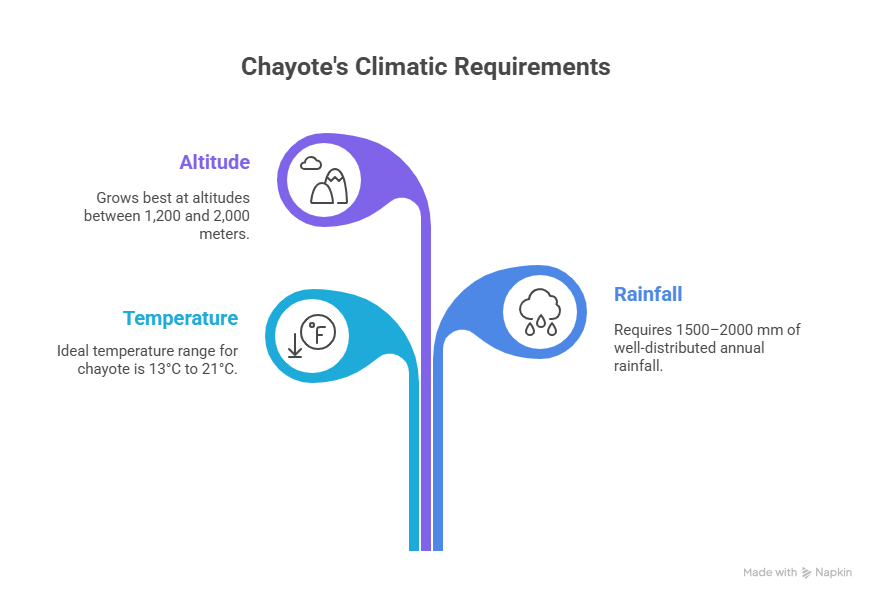
Although the crop is extremely susceptible to waterlogging, it needs a well-distributed yearly rainfall of 1500–2000 mm and stable soil moisture. It can be grown most successfully between 1,200 and 2,000 meters above sea level.
Major Cultivars
| Cultivar Name | Key Characteristics |
| Smooth Green | The most common type; features light to dark green, smooth skin. |
| Prickly or Rough | Distinctive for having spiny projections or prickles on the skin. |
| White/Off-White | Has smooth skin with a creamy-white or off-white coloration. |
| Criollo (Latin America) | A smaller-sized variety known for being more flavorful and having deep ridges on the fruit. |
| Local Selections | Not a formal cultivar; refers to landraces propagated by farmers from high-yielding, disease-resistant vines in their own fields. |
Propagation
Chayote is primarily propagated vegetatively by planting the entire mature fruit, which serves as both the seed and propagating material. Although methods such as stem cuttings or tuber propagation can be used, they are rarely practiced and generally considered less reliable compared to whole-fruit planting.
Seed Rate per Acre
Around 300 to 400 fruits are needed to plant one acre of chayote, with the exact requirement varying based on the spacing adopted.
Planting
a). Planting Season
Chayote is normally planted in tropical highlands during the beginning of the rainy season, which is usually in March or April or August or September in most places.
b). Spacing
Chayote has vigorous vine growth, so it requires wide spacing, with a common recommendation of 3 meters between rows and 2 meters between plants.
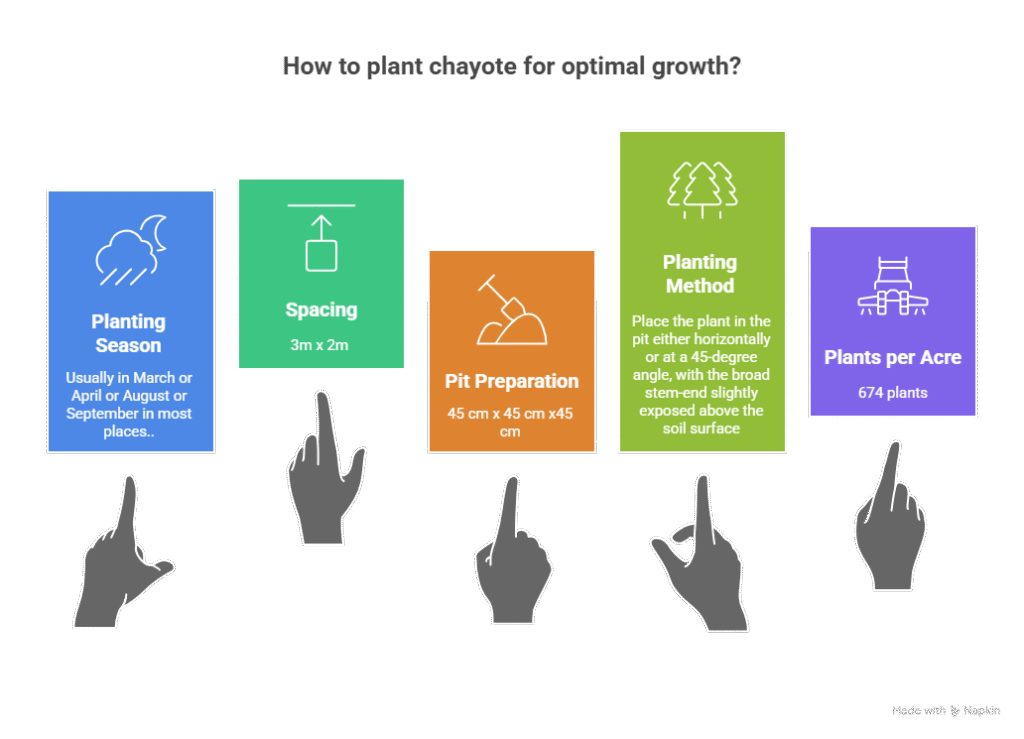
c). Pit Preparation
Pits of 45 cm x 45 cm x 45 cm are dug at the marked spots.
d). Planting Method
For planting chayote, each pit should be filled with a mixture of topsoil and 5–10 kg of well-rotted FYM or compost, along with a basal dose of fertilizer such as 100 g of SSP. A healthy, fully mature, and disease-free fruit should then be selected and placed in the pit either horizontally or at a 45-degree angle, with the broad stem-end slightly exposed above the soil surface, as burying the entire fruit may cause rotting. After placement, the pit should be covered properly, and light irrigation should be applied immediately to ensure good establishment.
e). Number of Plants per Acre
An acre of land can support roughly 674 chayote plants spaced 3 m by 2 m apart.
Intercropping
Intercropping with chayote is feasible only during the first 3–4 months after planting, before the vines spread fully and create dense shade. During this period, low-growing, early-maturing crops such as beans, radishes, lettuce, cabbage, or other leafy vegetables can be planted between the rows, allowing for efficient land use and providing additional income before the chayote begins yielding.
Irrigation
Chayote requires frequent irrigation during its germination, establishment, flowering, and fruit development stages. After planting, water the soil right away. During dry spells, irrigate the soil lightly every seven to ten days to keep it moist but not soggy.
Because drip irrigation saves water, provides moisture to the root zone directly, and keeps foliage dry, it lowers the danger of fungal diseases. Because mature vines have enormous tuberous roots that make them extremely drought-tolerant, irrigation frequency can be decreased once the rainy season begins or the plants are well established.
Fertilizer and Manure Application Guide
| Category | Application Stage | Dosage (per acre) | Notes / Timing |
| Compost | Preparation | 15-20 tonnes | Apply Farm Yard Manure (FYM) or compost. |
| Basal Dose | Pit Preparation | 15-20 tonnes FYM/Compost 50-60 kg N 40-50 kg P₂O₅ 60-80 kg K₂O | Example: Urea: 110 kg SSP: 250 kg MOP: 100 kg Adjust based on soil test results. |
| Biofertilizers | Planting | 800 g each of: • Azospirillum • PSB (Phosphate Solubilizing Bacteria) • Potash Mobilizing Bacteria | Apply during the planting stage. |
| Top Dressing | 30-40 Days After Planting | ¼ of the remaining Nitrogen (N) | First application. |
| At Vining & Trellising | ¼ of the total Nitrogen (N) | Second application. | |
| During Flowering | ¼ of the total Nitrogen (N) | Third application (half of the remaining N split into two). | |
| During Fruit Development | ¼ of the total Nitrogen (N) | Fourth and final application. | |
| Micronutrients | Foliar Spray | As recommended | Sprays of Boron and Zinc can be beneficial for improving fruit quality and fruit set. Apply as needed. |
Weed Control
Weed control is crucial during the first 3–4 months of crop growth to minimize competition for nutrients, water, and light, and it can be achieved through several methods.
Manual weeding, usually performed 2–3 times in the early stages, is necessary to keep the field clean, while mulching with materials such as straw, dry leaves, or black plastic mulch is highly effective in suppressing weed growth, conserving soil moisture, and regulating soil temperature.
Although chemical options like pre-emergence herbicides (e.g., Pendimethalin) can be applied carefully after planting, manual weeding and mulching are generally preferred for this crop.
Interculture Operation
Training
Training is a critical practice in chayote cultivation, requiring the construction of a strong overhead trellis (bower system) about 1.8–2.1 meters (6–7 feet) high using concrete posts, sturdy wood, or live supports. As the vines grow, they are manually guided onto the trellis, which improves air circulation, ensures better sunlight exposure for the leaves, facilitates spraying and harvesting, and ultimately produces straighter, higher-quality fruits.
Pruning
Excessive vegetative growth is pruned to encourage fruit production. Prune very long and tangled vines, especially those growing beyond the trellis. After harvest, a major pruning is done to remove old and unproductive branches, stimulating new growth for the next season.
Flowering and Fruit Management
Chayote is a monoecious plant, meaning it produces separate male and female flowers on the same vine. This unique characteristic ensures that a single plant can support pollination and fruiting without the need for multiple plants.
Chayote often starts to flower 4–5 months after planting, depending on the growth environment and cultivation techniques. For fruit to set successfully, pollen must be transferred from male to female flowers, and insects—bees in particular—are the main agents that enable pollination.
To achieve better fruit quality and yield, proper fruit management practices are essential. One effective technique is fruit thinning, where misshapen, damaged, or overly clustered young fruits are selectively removed.
Thinning reduces competition among developing fruits, allowing the remaining ones to grow more vigorously. As a result, the chayote fruits become larger, healthier, and more uniform in size, making them more suitable for the market.
Pest and Disease Management
Common Pests
Fruit Fly
Fruit fly is one of the most destructive pests in chayote cultivation. The female flies lay eggs just under the fruit skin, and the emerging larvae tunnel into the fruit, making it unfit for consumption or sale. Effective management includes using pheromone or food-bait traps to attract and kill adult flies, maintaining field sanitation by collecting and destroying infested fruits, and harvesting fruits promptly before they become overripe. For chemical control, spray Malathion 50 EC @ 2 ml per liter of water mixed with a protein bait (like jaggery or sugar solution) at weekly intervals during peak infestation.
Aphids and Spider Mites
Sap-sucking pests like spider mites and aphids harm leaves by consuming plant fluids, which causes curling, yellowing, and a decrease in plant vitality. They also secrete honeydew, which encourages the formation of sooty mold. Eco-friendly solutions for early infestations include insecticidal soaps or neem oil sprays (3–5 ml per liter of water). In extreme situations, the population can be controlled by foliar spraying systemic insecticides such as Dimethoate 30 EC @ 2 ml per liter of water or Imidacloprid 17.8 SL @ 0.3 ml per liter of water.
Epilachna Beetle
The epilachna beetle is another serious pest, with both larvae and adults scraping leaf tissues and leaving skeletonized patches, which reduce the plant’s photosynthetic capacity. Light infestations can be managed by hand-picking and destroying the beetles and larvae. Botanical pesticides such as neem seed kernel extract (NSKE 5%) are also effective. For heavy infestations, spraying Carbaryl 50 WP @ 2 g per liter of water or Chlorpyrifos 20 EC @ 2 ml per liter of water provides effective control.
Common Diseases
Powdery Mildew
Powdery mildew is a common disease of chayote, characterized by white, powdery fungal growth on the upper surface of leaves. It reduces photosynthesis, weakens the plant, and lowers fruit yield and quality. Proper cultural practices such as maintaining adequate plant spacing for air circulation and avoiding overhead irrigation help minimize its spread.
For chemical control, spray Wettable Sulfur 80 WP @ 2–3 g per liter of water at 10–15 day intervals. Alternatively, systemic fungicides such as Hexaconazole 5 EC @ 1 ml per liter of water or Triazole fungicides (Tebuconazole 250 EC @ 1 ml per liter) are also effective.
Downy Mildew
Downy mildew appears as yellow, angular spots on the upper leaf surface, with a characteristic purplish to gray fungal growth on the underside of the leaves. The disease spreads rapidly in humid conditions and can cause premature leaf drop, reducing plant vigor and yield. Management includes improving field drainage, avoiding overcrowding, and regular monitoring.
For chemical control, use Copper Oxychloride 50 WP @ 2.5 g per liter of water or Mancozeb 75 WP @ 2.5 g per liter of water as protective sprays. In severe cases, systemic fungicides like Metalaxyl + Mancozeb (Ridomil Gold MZ 72 WP) @ 2.5 g per liter can be applied at 10–12 day intervals.
Root Rot and Wilt
Root rot and wilt in chayote are usually caused by soil-borne fungi such as Fusarium and Pythium, often aggravated by poor drainage and waterlogging. Symptoms include wilting, root decay, and eventual plant death. Preventive measures include ensuring well-drained soils, avoiding over-irrigation, practicing crop rotation with non-host crops, and using healthy planting material.
For chemical management, drench the soil around the root zone with Carbendazim 50 WP @ 1 g per liter of water or Metalaxyl 35 WP @ 1.25 g per liter. For integrated control, combining cultural practices with fungicide drenching at early stages provides the best results.
Harvesting
Harvesting of chayote fruits generally begins around 120–150 days after planting, with the main harvesting season extending for several months depending on growing conditions.
Fruits are considered ready for harvest when they are tender, fully developed, and display a shiny skin. They should feel firm to the touch, and the ideal size for picking is about 10–15 cm in diameter. Overmature fruits lose their shine, become fibrous, and may even start sprouting, which reduces their market value.
Harvesting by hand is advised, with the fruit stalk being chopped with a sharp knife or secateurs. Fruits should be handled carefully to prevent bruising or damage. Harvesting is usually done once a week to guarantee a consistent supply of fresh, marketable vegetables.
Yield
The yield of chayote varies greatly depending on the cultivar, climate, and management practices, but a well-managed vine can produce 200 to 500 fruits during its productive season. On a per-acre basis, this amounts to approximately 8,000 to 20,000 kg per year. As a perennial crop, chayote can remain productive for 3 – 5 years under good management, with yields often peaking in the second year before gradually declining and requiring replanting.
Cost of Production of Chayote Farming per Acre
| S.N. | Categories | Cost (NRs.) |
| 1 | Land Preparation | 15,000 |
| 2 | Planting Materials | 3,000 |
| 3 | Planting | 2,000 |
| 4 | Fertilizers and Manure | 8,000 |
| 5 | Irrigation | 6,000 |
| 6 | Weed Control (pre & post-emergence) | 5,000 |
| 7 | Pest & Disease Control | 5,000 |
| 8 | Harvesting | 4,000 |
| 9 | Miscellaneous Costs | 5,000 |
| Total Cost (Initial Investment) | 53,000 |
Annual Maintenance cost per acre
The annual maintenance cost for chayote farming from the second year onward is estimated at about 40,000 NRs per acre, which generally includes expenses for fertilizers and manure application, irrigation management, weed control, pest and disease management, harvesting, and other miscellaneous activities required to sustain the crop’s productivity.
This recurring investment ensures healthy vine growth, consistent fruiting, and protection against yield losses, thereby maintaining profitability throughout the productive life cycle of the plantation.
Income per Acre from Chayote Farming
| Year | Estimated Yield (fruits/acre) | Market Price (NRs/fruit) | Total Income (NRs.) |
| 1st Year | 8,000 | 20 | 160,000 |
| 2nd Year | 11,000 | 20 | 220,000 |
| 3rd – 5th Year | 8,000 | 20 | 160,000 (per year) |
Analysis of Chayote farming Profit per Acre
| Year | Total Income (NRs.) | Total Cost (NRs.) | Net Profit (NRs.) |
| 1st Year | 160,000 | 53,000 | 107,000 |
| 2nd Year | 220,000 | 40,000 | 180,000 |
| 3rd Year | 160,000 | 40,000 | 120,000 |
| 4th Year | 160,000 | 40,000 | 120,000 |
| 5th Year | 160,000 | 40,000 | 120,000 |
Chayote farming demonstrates strong profitability, with the first year already yielding a significant profit of approximately 107,000 NRs and achieving break-even within the same year. Peak returns occur in the second year, driven by higher yields, resulting in a profit of 180,000 NRs, while from the third year onward, annual profits stabilize at around 120,000 NRs.
Overall, over a five-year period, chayote cultivation per acre generates a cumulative profit margin of approximately 75%, highlighting its potential as a highly lucrative horticultural investment.
Crop Calendar for Chayote Farming (Perennial Cycle)
This calendar outlines the key activities month-by-month for a chayote farm established in a typical tropical highland region, with a primary planting season at the start of the spring rain (e.g., March-April).
| Month (Example) | Growth Phase | Key Activities & Operations |
| Jan – Feb | Pre-Planting & Planning | Land Preparation: Deep plowing (30-40 cm) and harrowing. Pit Preparation: Dig pits (45x45x45 cm). Input Procurement: Source quality planting fruits, FYM (15-20 t/acre), fertilizers, and materials for trellising. |
| March – April | Planting & Establishment | Planting: Incorporate FYM + basal dose (N:P:K + SSP) into pits. Plant whole fruits. Irrigation: Provide immediate light irrigation. Weed Control: Apply pre-emergence herbicide or mulch after planting. Intercropping: Plant short-duration crops between rows. |
| May – June | Vegetative Growth | Trellising: Construct strong overhead trellis (1.8-2.1 m high). Training: Guide young vines onto the trellis. Top Dressing (1st): Apply ¼ of remaining N 30-40 days after planting. Weed Control: Perform manual weeding if necessary. Irrigation: Water every 7-10 days in dry spells. |
| July – Aug | Vegetative to Early Flowering | Top Dressing (2nd): Apply next ¼ N at the time of vining/trellising. Pest Monitoring: Start monitoring for aphids, spider mites, and beetles. Irrigation: Maintain soil moisture as flowering begins. |
| Sept – Oct | Flowering & Fruit Set | Top Dressing (3rd): Apply ¼ N during flowering. Pollination: Ensure healthy bee population for pollination. Pest Control: Manage fruit flies with traps; control aphids/mites with neem oil or recommended insecticides. Disease Control: Watch for powdery/downy mildew and apply preventive sprays. |
| Nov – Dec | Fruit Development & Harvest | Top Dressing (4th): Apply final ¼ N during fruit development. Harvesting Begins: Start harvesting tender, shiny fruits (120-150 days after planting). Harvest weekly. Micronutrients: Apply foliar sprays of Boron and Zinc if needed. |
| Jan – Feb (Year 2+) | Active Harvesting / Dormancy | Continued Harvest: Main harvesting season continues. Pruning: After harvest is complete, perform major pruning to remove old growth. Post-Harvest Care: Apply manure and prepare for the next cycle. Irrigation: Reduce frequency as plant may enter a slight dormancy in cooler periods. |
For PUMPKIN Farming: Pumpkin Farming Profit Per Acre
For Pointed Gourd Farming: Pointed Gourd Farming Profit Per Acre
Sources
Food and Agriculture Organization (FAO)
University of California Agriculture & Natural Resources (UC ANR)
European Plant Protection Organization (EPPO)
Punjab Agricultural University (PAU)
Tamil Nadu Agriculture University (TNAU) – Agritech portal
Indian Council of Agricultural Research (ICAR)
Nepal Agricultural Research Council (NARC)
U.S. Department of Agriculture (USDA).
Ministry of Agriculture and Livestock Development (Nepal)
Disclaimer: This crop farming profits assume optimal conditions. Actual results may vary depending on climate, market prices, and farm management practices.
